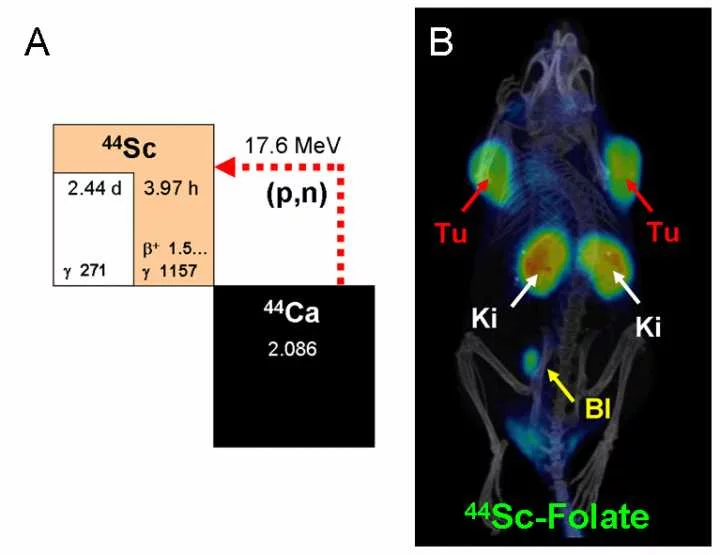Research Division Biology and Chemistry (BIO), Folate Receptor Targeting Group, Head Cristina Müller. In recent years, implementation of 68Ga-radiometalated peptides for PET imaging of cancer has attracted the attention of clinicians. Herein, we propose the use of 44Sc (half-life = 3.97 h, average β+ energy [Eβ+av] = 632 keV) as a valuable alternative to 68Ga (half-life = 68 min, Eβ+av = 830 keV) for imaging and dosimetry before 177Lu-based radionuclide therapy. The aim of the study was the preclinical evaluation of a folate conjugate labeled with cyclotron-produced 44Sc and its in vitro and in vivo comparison with the 177Lu-labeled pendant. Methods: 44Sc was produced via the 44Ca(p,n)44Sc nuclear reaction at a cyclotron (17.6 ± 1.8 MeV, 50 μA, 30 min) using an enriched 44Ca target (10 mg 44CaCO3, 97.00%). Separation from the target material was performed by a semiautomated process using extraction chromatography and cation exchange chromatography. Radiolabeling of a DOTA-folate conjugate (cm09) was performed at 95°C within 10 min. The stability of 44Sc-cm09 was tested in human plasma. 44Sc-cm09 was investigated in vitro using folate receptor–positive KB tumor cells and in vivo by PET/CT imaging of tumor-bearing mice Results: Under the given irradiation conditions, 44Sc was obtained in a maximum yield of 350 MBq at high radionuclide purity (>99%). Semiautomated isolation of 44Sc from 44Ca targets allowed formulation of up to 300 MBq of 44Sc in a volume of 200–400 μL of ammonium acetate/HCl solution (1 M, pH 3.5–4.0) within 10 min. Radiolabeling of cm09 was achieved with a radiochemical yield of greater than 96% at a specific activity of 5.2 MBq/nmol. In vitro, 44Sc-cm09 was stable in human plasma over the whole time of investigation and showed folate receptor–specific binding to KB tumor cells. PET/CT images of mice injected with 44Sc-cm09 allowed excellent visualization of tumor xenografts. Comparison of cm09 labeled with 44Sc and 177Lu revealed almost identical pharmacokinetics. Conclusion: This study presents a high-yield production and efficient separation method of 44Sc at a quality suitable for radiolabeling of DOTA-functionalized biomolecules. An in vivo proof-of-concept study using a DOTA-folate conjugate demonstrated the excellent features of 44Sc for PET imaging. Thus, 44Sc is a valid alternative to 68Ga for imaging and dosimetry before 177Lu-radionuclide tumor therapy.
Publication: http://dx.doi.org/10.2967/jnumed.113.123810
Further publications: ZRW Homepage


